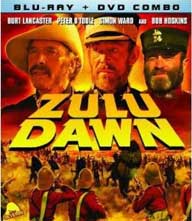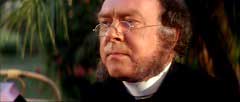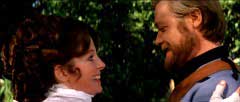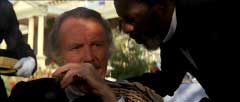 ZULU
DAWN (1979) Blu-ray/DVD combo
ZULU
DAWN (1979) Blu-ray/DVD comboDirector: Douglas Hickox
Severin Films
 ZULU
DAWN (1979) Blu-ray/DVD combo
ZULU
DAWN (1979) Blu-ray/DVD comboSeverin Films follows up their very Blu-ray/DVD combo releases of the “un-Severin” epics THE WILD GEESE and ASHANTI with ZULU DAWN, the 1979 prequel to the events of ZULU (1964).

Despite the English government’s preference to negotiate with the Zulus – whose land is separated from the expanding Cape Colony by the Buffalo River – ambitious British High Commissioner Sir Henry Bartle Frere (John Mills, GANDHI) and commander of South Africa’s British forces Lord Chelmsford (Peter O’Toole, LAWRENCE OF ARABIA) demand that Zulu leader Cetshwayo (Simon Sabela, ZULU) and his men lay down their arms. They use his proud refusal to justify going to war against Zululand and set about instilling fear among the Cape Colony high society (who have managed to live along the border without incident). Thirty-thousand Zulu warriors is a formidable enemy, but Lord Chelmsford’s arrogance and dismissive attitude towards intelligence from those who have experience with the Zulus – including Colonel Durnford (Burt Lancaster, CONVERSATION PIECE), who Chelmsford believes wants to undermine his command, and Lt. William Vereker (Simon Ward, HOLOCAUST 2000) – may prove to be more self-destructive.
 ZULU
writer/producer/director Cy Endfield scripted ZULU DAWN as a prequel to his
1964 film, but the film was directed by Douglas Hickox (THEATER OF BLOOD) –
father of Anthony Hickox (WAXWORK) and James D.R. Hickox (CHILDREN OF THE CORN
III: URBAN HARVEST) with editor Anne V. Coates (LAWRENCE OF ARABIA) –
since Endfield had given up directing after the failure of his 1971 film UNIVERSAL
SOLDIER (prior to that, he had been replaced on Roger Corman’s AIP production
of DE SADE by Gordon Hessler, although Endfield still receives credit). ZULU
DAWN was not well-received upon release, and that may be partly because it was
either ahead of its time or behind it. Rather than a “Boy’s Own”
adventure like ZULU (1964) – or THE WILD GEESE (1978), to name not only
a British production more contemporary with ZULU DAWN’s production as
well as another Severin release – its portrayal of self-interest and manipulation
of those in power, as well as the cheerfully racist attitudes of various characters,
and dialogue about the cultural relativity of savage behavior would probably
go over better had the film been made now. Had it been made a decade earlier,
the approach might have had a counter-culture appeal (M*A*S*H fans probably
would have found the characters in ZULU DAWN who provide the voices of reason
all rather too soft-spoken, or downright mumbly when it comes to Ronald Lacey’s
[RAIDERS OF THE LOST ARK] “politicking” newsman).
ZULU
writer/producer/director Cy Endfield scripted ZULU DAWN as a prequel to his
1964 film, but the film was directed by Douglas Hickox (THEATER OF BLOOD) –
father of Anthony Hickox (WAXWORK) and James D.R. Hickox (CHILDREN OF THE CORN
III: URBAN HARVEST) with editor Anne V. Coates (LAWRENCE OF ARABIA) –
since Endfield had given up directing after the failure of his 1971 film UNIVERSAL
SOLDIER (prior to that, he had been replaced on Roger Corman’s AIP production
of DE SADE by Gordon Hessler, although Endfield still receives credit). ZULU
DAWN was not well-received upon release, and that may be partly because it was
either ahead of its time or behind it. Rather than a “Boy’s Own”
adventure like ZULU (1964) – or THE WILD GEESE (1978), to name not only
a British production more contemporary with ZULU DAWN’s production as
well as another Severin release – its portrayal of self-interest and manipulation
of those in power, as well as the cheerfully racist attitudes of various characters,
and dialogue about the cultural relativity of savage behavior would probably
go over better had the film been made now. Had it been made a decade earlier,
the approach might have had a counter-culture appeal (M*A*S*H fans probably
would have found the characters in ZULU DAWN who provide the voices of reason
all rather too soft-spoken, or downright mumbly when it comes to Ronald Lacey’s
[RAIDERS OF THE LOST ARK] “politicking” newsman).

O’Toole is a bit too restrained; which may have been historically-accurate to his character, but some CALIGULA-level ham might have made his character seem more odious than ignorant. Lancaster is unfortunately hampered by his accent, but – like Ward at his stiff-upper-lip best – is not afforded enough screen time despite his billing. The peopling of the supporting cast with actors such as Denholm Elliot (THE HOUSE THAT DRIPPED BLOOD), Nigel Davenport (CHARIOTS OF FIRE), Peter Vaughn (DIE, DIE MY DARLING), Freddie Jones (THE SATANIC RITES OF DRACULA), Ken Gampu (KILL AND KILL AGAIN) and Bob Hoskins (BRAZIL) – doing their effortless best in too-small roles – says less about the pedigree of the film and more about the slump in British filmmaking in the 1970s (which also consigned up-and-coming British talent in the cast like Christopher Cazenove [HEAT AND DUST], Nicholas Clay [EXCALIBUR], and Phil Daniels [SCUM] to mostly television guest shots).
 The
film attempts to set up the sort of relationships where opposed characters develop
a grudging respect among several supporting characters including Durnford and
Vereker – who are both infatuated with vicar’s daughter Fanny (Anna
Calder-Marshall, WUTHERING HEIGHTS) – newsman Newman and Chelmsford’s
secretary Colonel Crealock (Michael Jayston, NICHOLAS AND ALEXANDRA) –
who takes shallow comfort in following Chelmsford’s strategy despite his
doubts about it – among others; however, it’s all really for naught
since the crux is Chelmsford’s leadership. The not-exactly-epic sub-two
hour running time also does not allow for sufficient development; and it’s
hard to balance sympathy towards these few sympathetic characters (Ronald Pickup’s
Lt. Harford is the only one who seems concerned that a few black attendants
have drowned while the arms officer is more concerned over the ruined cases
of bullets that must be accounted for) against the film’s position on
the British army as a whole, so the slaughter of these characters amidst the
spectacle of the battle scenes lacks resonance. Elmer Bernstein’s score
lacks memorable themes along the lines of John Barry’s ZULU score, but
the Panavision cinematography of Ousama Rawi – assisted by GHANDI cinematographer
Ronnie Taylor – is consistently gorgeous.
The
film attempts to set up the sort of relationships where opposed characters develop
a grudging respect among several supporting characters including Durnford and
Vereker – who are both infatuated with vicar’s daughter Fanny (Anna
Calder-Marshall, WUTHERING HEIGHTS) – newsman Newman and Chelmsford’s
secretary Colonel Crealock (Michael Jayston, NICHOLAS AND ALEXANDRA) –
who takes shallow comfort in following Chelmsford’s strategy despite his
doubts about it – among others; however, it’s all really for naught
since the crux is Chelmsford’s leadership. The not-exactly-epic sub-two
hour running time also does not allow for sufficient development; and it’s
hard to balance sympathy towards these few sympathetic characters (Ronald Pickup’s
Lt. Harford is the only one who seems concerned that a few black attendants
have drowned while the arms officer is more concerned over the ruined cases
of bullets that must be accounted for) against the film’s position on
the British army as a whole, so the slaughter of these characters amidst the
spectacle of the battle scenes lacks resonance. Elmer Bernstein’s score
lacks memorable themes along the lines of John Barry’s ZULU score, but
the Panavision cinematography of Ousama Rawi – assisted by GHANDI cinematographer
Ronnie Taylor – is consistently gorgeous.

ZULU DAWN comes to Blu-ray (in a combo with DVD copy) with its correct Panavision framing (exactly 2.35:1) restored. While Severin’s previous discs of THE WILD GEESE and ASHANTI utilized MPEG-2 encoding, their BD25 of ZULU DAWN features an AVC MPEG-4 encoding. Like ASHANTI and THE WILD GEESE, I suspect the HD master is older but it's certainly the best looking of Severin’s Victory Films-licensed titles (the end credits feature a new 2004 copyright citing the original producers, but the presentation begins with a Victory Films logo). While a BD50 rendering would have been nicer, the Blu-ray image is still the preferable one here; the DVD is of course less detailed, but it also looks a tad darker and is not always able to handle the contrast of the sunny exteriors. Sadly not restored is the film’s original Dolby Stereo track. Severin’s David Gregory informed me that they were unable to find a stereo English track (the French release reportedly has a stereo track, but only in French [French posters do sport a Dolby Stereo logo]). While the aforementioned Severin releases featured lossy Dolby Digital tracks on both Blu-ray and DVD, ZULU DAWN includes the mono track in DTS-HD Master Audio 1.0; however, the disc defaults to a Dolby Digital 2.0 mono track is also included (the DVD also includes the Dolby Digital 2.0 track as well as a half-bitrate DTS 1.0 track).
 The
bulk of the extras give more context to the war itself than the production.
In “The History of the Zulu Wars” (25:31), Ian Knight, author of
the book “Zulu Rising”, talks about the battles of Isandlwanda and
Roarke’s Drift (news of the invasion of Roarke’s Drift reaches Chelmsford
at the end of the film and was depicted in Endfield’s earlier ZULU). In
“A Visit to the Battlefield” (16:45), Knight appears on location
– managing to speak over the wind buffeting the microphone – describes
the background of the locations and details from the battle. He points out that
the soldiers actually cross the river from the Zulu side in the film, presumably
because the background was more visually interesting. More interesting is “Recreating
the War” (20:18), in which the film’s historical advisor Midge Carter
– a military historian – discusses how he became part of the project
(from a newspaper article looking for historical advisors). Carter’s discussions
with the art director lead to discoveries about various inaccuracies about details
(including the blocking of the war initially planned from a map printed upside
down). He also discusses the contributions of fellow historical advisor John
Mollo (who was working on STAR WARS at the same time), and working with extras
recruited from a local lunatic asylum. He has vivid memories of the shoot, including
a humorous recollection of a continuity gaffe – involving a Zulu running
in green Nike shoes – that necessitated the restaging of a massive scene.
The
bulk of the extras give more context to the war itself than the production.
In “The History of the Zulu Wars” (25:31), Ian Knight, author of
the book “Zulu Rising”, talks about the battles of Isandlwanda and
Roarke’s Drift (news of the invasion of Roarke’s Drift reaches Chelmsford
at the end of the film and was depicted in Endfield’s earlier ZULU). In
“A Visit to the Battlefield” (16:45), Knight appears on location
– managing to speak over the wind buffeting the microphone – describes
the background of the locations and details from the battle. He points out that
the soldiers actually cross the river from the Zulu side in the film, presumably
because the background was more visually interesting. More interesting is “Recreating
the War” (20:18), in which the film’s historical advisor Midge Carter
– a military historian – discusses how he became part of the project
(from a newspaper article looking for historical advisors). Carter’s discussions
with the art director lead to discoveries about various inaccuracies about details
(including the blocking of the war initially planned from a map printed upside
down). He also discusses the contributions of fellow historical advisor John
Mollo (who was working on STAR WARS at the same time), and working with extras
recruited from a local lunatic asylum. He has vivid memories of the shoot, including
a humorous recollection of a continuity gaffe – involving a Zulu running
in green Nike shoes – that necessitated the restaging of a massive scene.
 Also
included are the theatrical trailer (3:00) and a selection of outtakes (12:13)
– in expectedly horrid condition (the non-anamorphic 2.35:1 letterboxed
footage is stretched to 16:9 on both Blu-ray and DVD). Although one might have
concern for the inclusion of roughly seventy-five minutes of extras on a BD25
with a two hour film, only “The History of the Zulu Wars” is in
1080p while the other extras are 480p (also encoded in AVC MPEG-4 with 192 kbps
Dolby Digital 2.0 audio). A bit of sloppiness on the combo set’s back
cover – which does not mention the outtakes in its special features –
is the credit “Thierry de Ganay presents une production Lambart”
above the ZULU DAWN credits. Ganay appears to have had nothing to do with ZULU
DAWN, although he did producer THE HAIRDRESSER’S HUSBAND and THE PERFUME
OF YVONNE (which were both released on DVD by Severin Films).
(Eric
Cotenas)
Also
included are the theatrical trailer (3:00) and a selection of outtakes (12:13)
– in expectedly horrid condition (the non-anamorphic 2.35:1 letterboxed
footage is stretched to 16:9 on both Blu-ray and DVD). Although one might have
concern for the inclusion of roughly seventy-five minutes of extras on a BD25
with a two hour film, only “The History of the Zulu Wars” is in
1080p while the other extras are 480p (also encoded in AVC MPEG-4 with 192 kbps
Dolby Digital 2.0 audio). A bit of sloppiness on the combo set’s back
cover – which does not mention the outtakes in its special features –
is the credit “Thierry de Ganay presents une production Lambart”
above the ZULU DAWN credits. Ganay appears to have had nothing to do with ZULU
DAWN, although he did producer THE HAIRDRESSER’S HUSBAND and THE PERFUME
OF YVONNE (which were both released on DVD by Severin Films).
(Eric
Cotenas)